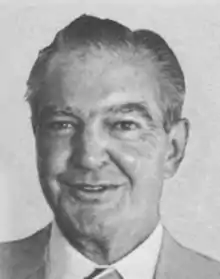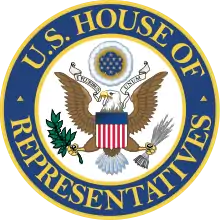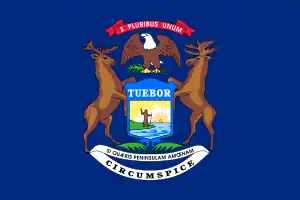Harold S. Sawyer
Harold Samuel Sawyer (March 21, 1920 – April 3, 2003) was an American attorney and politician from the U.S. state of Michigan. Born and raised in the San Francisco Bay Area, Sawyer represented Michigan's 5th congressional district in the United States House of Representatives from 1977 to 1985.
Harold Sawyer | |
|---|---|
 | |
| Member of the U.S. House of Representatives from Michigan's 5th district | |
| In office January 3, 1977 – January 3, 1985 | |
| Preceded by | Richard Vander Veen |
| Succeeded by | Paul Henry |
| Personal details | |
| Born | March 21, 1920 San Francisco, California, U.S. |
| Died | April 3, 2003 (aged 83) Algoma Township, Michigan, U.S. |
| Political party | Republican |
| Alma mater | Marin Junior College University of California, Berkeley (BA) Hastings College of the Law (JD) |
| Occupation | Attorney |
| Military service | |
| Branch/service | |
| Battles/wars | World War II |
Early life and education
Sawyer was born in San Francisco, California.[1] He attended public schools of the San Francisco Bay area before graduating from Marin Junior College (now the College of Marin), Kentfield, California and from the University of California, Berkeley in 1940. He earned a J.D. from the University of California, Hastings College of the Law in 1943.
Career
He served in the United States Navy during World War II, after which he settled in Grand Rapids, Michigan and established a successful private law practice.
From 1968 to 1976, Sawyer was a member of the Michigan Law Revision Commission. From 1975 to 1976, he was prosecuting attorney for Kent County. In 1976, Sawyer defeated incumbent Democrat Richard Vander Veen to reclaim Michigan's 5th congressional district for the Republicans. The seat had been held by Gerald R. Ford until he was appointed to become Vice President of the United States. Sawyer was elected to the Ninety-fifth and to the three succeeding Congresses, serving from January 3, 1977 to January 3, 1985. He was not a candidate for reelection to the Ninety-ninth Congress in 1984.
Sawyer served on the House Select Committee on Assassinations investigating the assassinations of John F. Kennedy and Martin Luther King, Jr.[2] Sawyer was one of four members who dissented from the Committee's finding that Dictabelt evidence suggested that Kennedy was "probably assassinated as a result of a conspiracy."[2] Responding to a question asking how he would handle the Committee's report if he were at the Justice Department, he replied: "I'd file it in a circular file."[3] Sawyer stated that the conclusions in both cases were based on "supposition upon supposition upon supposition".[4]
Death
In 2003, Sawyer died of throat cancer at his home in Algoma Township. He is interred in Rockford Cemetery, in Rockford, Michigan.
References
- "United States Census, 1930", FamilySearch, retrieved March 19, 2018
- Wicker, Tom (July 22, 1979). "Controversy masks key assassination finding". Eugene Register-Guard. Eugene, Oregon. p. 27A. Retrieved December 15, 2014.
- "Stokes wants follow-up of conspiracy hypothesis". The Bulletin. Bend, Oregon. July 18, 1979. p. 12. Retrieved December 15, 2014.
- "Panel: JFK murder conspiracy 'possible'". Wilmington Morning Star. 112 (232). Wilmington, North Carolina. AP. July 18, 1979. p. 3-A. Retrieved May 29, 2015.
- United States Congress. "Harold S. Sawyer (id: S000087)". Biographical Directory of the United States Congress.
External links
- Harold S. Sawyer at Find a Grave
- Statement from Representative Vernon J. Ehlers upon Sawyer's death
- Harold Sawyer, R.I.P. by John Gizzi in Human Events, April 28, 2003
- Appearances on C-SPAN
| U.S. House of Representatives | ||
|---|---|---|
| Preceded by Richard Vander Veen |
United States Representative for the 5th Congressional District of Michigan 1977–1985 |
Succeeded by Paul B. Henry |

